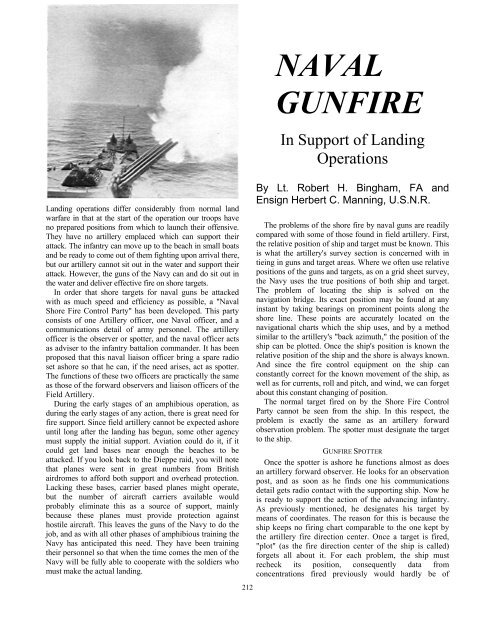the field artillery journal - Fort Sill - U.S. Army
the field artillery journal - Fort Sill - U.S. Army
the field artillery journal - Fort Sill - U.S. Army
You also want an ePaper? Increase the reach of your titles
YUMPU automatically turns print PDFs into web optimized ePapers that Google loves.
Landing operations differ considerably from normal land<br />
warfare in that at <strong>the</strong> start of <strong>the</strong> operation our troops have<br />
no prepared positions from which to launch <strong>the</strong>ir offensive.<br />
They have no <strong>artillery</strong> emplaced which can support <strong>the</strong>ir<br />
attack. The infantry can move up to <strong>the</strong> beach in small boats<br />
and be ready to come out of <strong>the</strong>m fighting upon arrival <strong>the</strong>re,<br />
but our <strong>artillery</strong> cannot sit out in <strong>the</strong> water and support <strong>the</strong>ir<br />
attack. However, <strong>the</strong> guns of <strong>the</strong> Navy can and do sit out in<br />
<strong>the</strong> water and deliver effective fire on shore targets.<br />
In order that shore targets for naval guns be attacked<br />
with as much speed and efficiency as possible, a "Naval<br />
Shore Fire Control Party" has been developed. This party<br />
consists of one Artillery officer, one Naval officer, and a<br />
communications detail of army personnel. The <strong>artillery</strong><br />
officer is <strong>the</strong> observer or spotter, and <strong>the</strong> naval officer acts<br />
as adviser to <strong>the</strong> infantry battalion commander. It has been<br />
proposed that this naval liaison officer bring a spare radio<br />
set ashore so that he can, if <strong>the</strong> need arises, act as spotter.<br />
The functions of <strong>the</strong>se two officers are practically <strong>the</strong> same<br />
as those of <strong>the</strong> forward observers and liaison officers of <strong>the</strong><br />
Field Artillery.<br />
During <strong>the</strong> early stages of an amphibious operation, as<br />
during <strong>the</strong> early stages of any action, <strong>the</strong>re is great need for<br />
fire support. Since <strong>field</strong> <strong>artillery</strong> cannot be expected ashore<br />
until long after <strong>the</strong> landing has begun, some o<strong>the</strong>r agency<br />
must supply <strong>the</strong> initial support. Aviation could do it, if it<br />
could get land bases near enough <strong>the</strong> beaches to be<br />
attacked. If you look back to <strong>the</strong> Dieppe raid, you will note<br />
that planes were sent in great numbers from British<br />
airdromes to afford both support and overhead protection.<br />
Lacking <strong>the</strong>se bases, carrier based planes might operate,<br />
but <strong>the</strong> number of aircraft carriers available would<br />
probably eliminate this as a source of support, mainly<br />
because <strong>the</strong>se planes must provide protection against<br />
hostile aircraft. This leaves <strong>the</strong> guns of <strong>the</strong> Navy to do <strong>the</strong><br />
job, and as with all o<strong>the</strong>r phases of amphibious training <strong>the</strong><br />
Navy has anticipated this need. They have been training<br />
<strong>the</strong>ir personnel so that when <strong>the</strong> time comes <strong>the</strong> men of <strong>the</strong><br />
Navy will be fully able to cooperate with <strong>the</strong> soldiers who<br />
must make <strong>the</strong> actual landing.<br />
212<br />
NAVAL<br />
GUNFIRE<br />
In Support of Landing<br />
Operations<br />
By Lt. Robert H. Bingham, FA and<br />
Ensign Herbert C. Manning, U.S.N.R.<br />
The problems of <strong>the</strong> shore fire by naval guns are readily<br />
compared with some of those found in <strong>field</strong> <strong>artillery</strong>. First,<br />
<strong>the</strong> relative position of ship and target must be known. This<br />
is what <strong>the</strong> <strong>artillery</strong>'s survey section is concerned with in<br />
tieing in guns and target areas. Where we often use relative<br />
positions of <strong>the</strong> guns and targets, as on a grid sheet survey,<br />
<strong>the</strong> Navy uses <strong>the</strong> true positions of both ship and target.<br />
The problem of locating <strong>the</strong> ship is solved on <strong>the</strong><br />
navigation bridge. Its exact position may be found at any<br />
instant by taking bearings on prominent points along <strong>the</strong><br />
shore line. These points are accurately located on <strong>the</strong><br />
navigational charts which <strong>the</strong> ship uses, and by a method<br />
similar to <strong>the</strong> <strong>artillery</strong>'s "back azimuth," <strong>the</strong> position of <strong>the</strong><br />
ship can be plotted. Once <strong>the</strong> ship's position is known <strong>the</strong><br />
relative position of <strong>the</strong> ship and <strong>the</strong> shore is always known.<br />
And since <strong>the</strong> fire control equipment on <strong>the</strong> ship can<br />
constantly correct for <strong>the</strong> known movement of <strong>the</strong> ship, as<br />
well as for currents, roll and pitch, and wind, we can forget<br />
about this constant changing of position.<br />
The normal target fired on by <strong>the</strong> Shore Fire Control<br />
Party cannot be seen from <strong>the</strong> ship. In this respect, <strong>the</strong><br />
problem is exactly <strong>the</strong> same as an <strong>artillery</strong> forward<br />
observation problem. The spotter must designate <strong>the</strong> target<br />
to <strong>the</strong> ship.<br />
GUNFIRE SPOTTER<br />
Once <strong>the</strong> spotter is ashore he functions almost as does<br />
an <strong>artillery</strong> forward observer. He looks for an observation<br />
post, and as soon as he finds one his communications<br />
detail gets radio contact with <strong>the</strong> supporting ship. Now he<br />
is ready to support <strong>the</strong> action of <strong>the</strong> advancing infantry.<br />
As previously mentioned, he designates his target by<br />
means of coordinates. The reason for this is because <strong>the</strong><br />
ship keeps no firing chart comparable to <strong>the</strong> one kept by<br />
<strong>the</strong> <strong>artillery</strong> fire direction center. Once a target is fired,<br />
"plot" (as <strong>the</strong> fire direction center of <strong>the</strong> ship is called)<br />
forgets all about it. For each problem, <strong>the</strong> ship must<br />
recheck its position, consequently data from<br />
concentrations fired previously would hardly be of

















